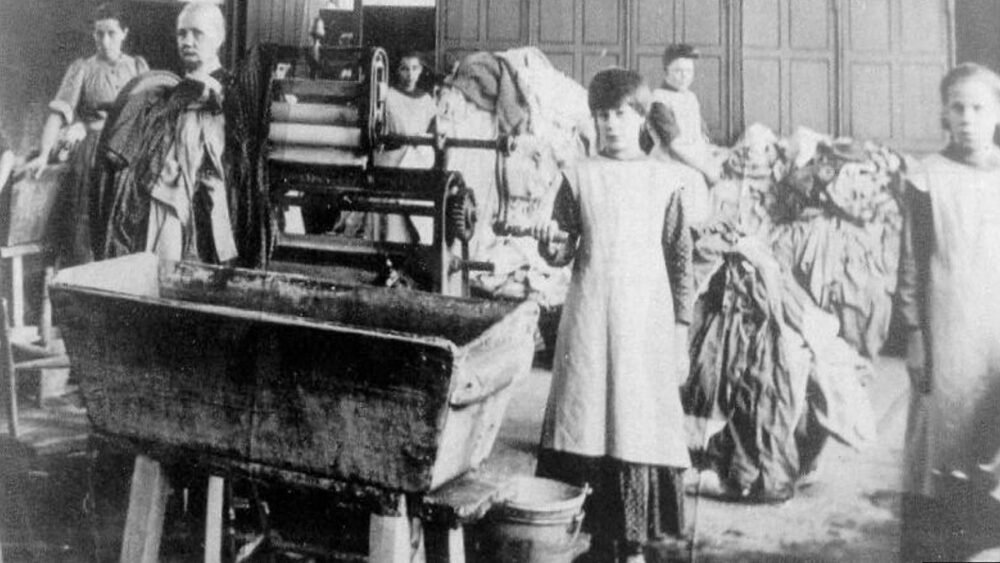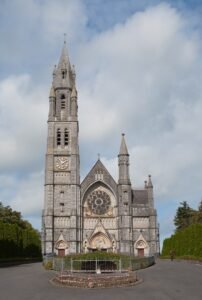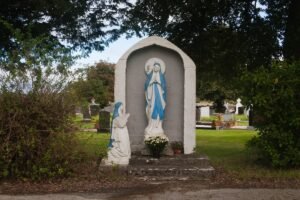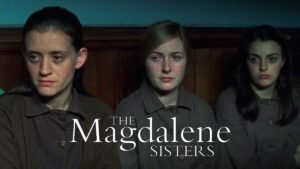The Truth About Magdalene Laundries in Ireland

Do you know the truth about Magdalene Laundries? Ireland has gone from being an extremely conservative and religious country to a slowly, more progressive and open-minded one. In the second half of the 20th Century, and the first half of the 21st Century we have decriminalised homosexuality, divorce, same-sex marriage, and most recently abortion. What may have seemed impossible 100 years ago is not only possible now, but celebrated.
 And yet, we have a long way to go. In November 2020, over 6,600 images of nude women were leaked on Discord. Some of these images included child pornagraphy. Our latest battle with the state is in our efforts to criminalise this kind of behaviour, to criminalise the action of leaking such photographs, or sending them anywhere beyond where the taker of the photos wanted them to go. People have taken their lives over this happening to them. It’s time, as with everything else we have overcome in Ireland, to say enough is enough.
And yet, we have a long way to go. In November 2020, over 6,600 images of nude women were leaked on Discord. Some of these images included child pornagraphy. Our latest battle with the state is in our efforts to criminalise this kind of behaviour, to criminalise the action of leaking such photographs, or sending them anywhere beyond where the taker of the photos wanted them to go. People have taken their lives over this happening to them. It’s time, as with everything else we have overcome in Ireland, to say enough is enough.
What does this have to do with Magdalene Laundries you ask?
The Magdalene Laundries are often thought of as a medieval practice, or at the very least, something that took place up until the 40s, 50s, maybe the late 60s at a stretch. What most people are shocked to learn, is that the last of these institutions did not shut down in Ireland until 1996. Irish women have only been free of them for 24 years. Such a thought seems to be impossible, but those are the facts. As we have recently learnt from the leaked images on Discord, Ireland still has a long way to progress when it comes to giving women autonomy over their bodies, both physically and digitally. The devastating truth about Magdalene Laundries is that they are in our very recent history, and we need to progress faster for our future generations’ sakes.
The First Magdalene Laundries
Although they are thought to be primarily Catholic institutions, this is a misconception. The first Magdalene Laundry opened in 1767 on Leeson Street and was open to Protestant women only. Catholics opened their own asylums, and both religions believed in the power of them to rehabilitate “bad women” or women who did not conform to the prescribed Irish female identity. This identity was a woman who would wait to have sex until marriage, would be a stay at home mother, a faithful wife, and any deviation from this identity was seen as wrong. Magdalene Laundries are named after Mary Magdalene from the Bible, who began following Jesus after a life that was considered “unsavoury.” In a Magdalene Laundry, women would be put to work, washing and cleaning clothes, and would participate in gruelling prayer to atone for their “sins.” The idea was that through this hard work, these women would be granted absolution and return to society safely, without endangering themselves or others. As the centuries went on, what began as short stints in these asylums got longer, and some women spent their whole lives here.
When these asylums first opened, many women entered them voluntarily, seeking shelter or refuge, and would learn skills they could then apply when they left. However, it became increasingly difficult to leave the laundries and rather than providing education and shelter, these women got punishment and prayer. They were not paid for their work, which made leaving one on one’s own terms almost impossible.
Magdalene Laundries in the 20th Century
Women were often put into laundries for no justifiable reason. If a woman was raped she was sometimes institutionalised, and her rapist would see no repercussions for his actions. If these women fell pregnant, their babies would be taken from them and given to wealthy families, and became untraceable afterwards.
 These institutions were entirely run by the Church, with the approval and funding of the State. People either pretended they didn’t know about them, or didn’t consider how terrible these institutions really were. People stayed quiet, and the laundries continued to run. This was a time where homosexuality was illegal, as was divorce, and where women were forced to give up their jobs once they were married. To this day, women feel shame around what happened to them, and even when laundries began shutting down, a lot of women were too institutionalised to return to society, having spent years seeped in guilt and shame.
These institutions were entirely run by the Church, with the approval and funding of the State. People either pretended they didn’t know about them, or didn’t consider how terrible these institutions really were. People stayed quiet, and the laundries continued to run. This was a time where homosexuality was illegal, as was divorce, and where women were forced to give up their jobs once they were married. To this day, women feel shame around what happened to them, and even when laundries began shutting down, a lot of women were too institutionalised to return to society, having spent years seeped in guilt and shame.
There were several routes of entry to Magdalene Laundries. The State ways were via the criminal justice system, the industrial and reformatory schools, and the health authorities. Non-state routes of entry included family members, Catholic priests, and those who self-referred.
1980s Ireland
 In the final 10 years of the Laundries’ life span, the hypocrisies in Ireland, particularly surrounding women having babies out of wedlock, were ever present. This can be witnessed best in two cases. First, in 1984, a 15 year old girl named Ann Lovett died while giving birth beside a grotto dedicated to the Virgin Mary (yes, really) because she had kept her pregnancy a secret and felt so alone. This happened in Granard, Co. Longford, and it has since been considered that not only did most of the town know of Ann’s condition, but simply ignored it, even though it is highly likely that the father of the child was an adult neighbour.
In the final 10 years of the Laundries’ life span, the hypocrisies in Ireland, particularly surrounding women having babies out of wedlock, were ever present. This can be witnessed best in two cases. First, in 1984, a 15 year old girl named Ann Lovett died while giving birth beside a grotto dedicated to the Virgin Mary (yes, really) because she had kept her pregnancy a secret and felt so alone. This happened in Granard, Co. Longford, and it has since been considered that not only did most of the town know of Ann’s condition, but simply ignored it, even though it is highly likely that the father of the child was an adult neighbour.
The second case that portrays this hypocrisy is the Kerry Babies Scandal, also in 1984. Joanne Hayes was pregnant, but lost her child and buried them; at this same time, another baby’s body was discovered buried on the beach, and the Gardaí, aware of Hayes’ pregnancy, insisted she had killed this child and the one she’d actually been carrying. She was considered suspicious because she was an unmarried mother. There was no evidence to support this, but the case continued for four more years, and the actual killer of the baby has never been discovered.
Something had to give with stories like this continuing in Ireland well into the 1980s. The attitude towards women getting pregnant out of wedlock, indeed, having sex outside of marriage had to change. Ann would perhaps not have lost her life, and Joanne wouldn’t have had to deal with the scrutiny and accusations of killing a baby that was never hers to begin with.
You can read more on Ann Lovett here and Joanne Hayes here.
Tuam

The Bon Secours Mother and Baby Home located in Tuam ran from 1925 to 1961. Similar to a Magdalene Laundry, unwed mothers were sent here to have their babies. After these babies were born, many of them who weren’t adopted died, some even starved to death, and it is now believed that up to 800 babies’ remains were found on the premises. Journalist Catherine Corless continued to investigate Tuam, and is largely why we know so much about these atrocities today. You can read more about Tuam here. Reader discretion is advised.
The McAleese Report
In 1992, after a mass grave was discovered, Ireland’s secret of containment was thrown wide open and people were outraged. For the first time, the evidence was too clear for society to ignore, and there was a thorough investigation done into the crimes of Magdalene Laundries, largely through testimonies. Below I’ll leave a few extracts from the report from women who formerly suffered due to their incarceration.
A general misconception about the laundries is that all of these women were beaten with their heads shaved – the report seemed to debunk this idea, but that didn’t mean these places weren’t abusive, and unfortunately in some of these asylums, physical violence was used. From 1922, there were 10 Magdalene Laundries running across the country and it is thought that up to 10,000 women were contained during the time they were open. These women would have all attended different laundries, with different nuns, and different rules, meaning just because in one laundry there wasn’t violence, doesn’t mean this was the case in another.
- One woman said the nuns were “very cruel, but they couldn’t hit us … physical cruelty didn’t happen, but mental cruelty did” (Chapter 19)
- However, every laundry was different, and another woman described a physical assault by two auxiliaries (women who were in the laundry by their own will). She said that they made her undress and then that she was, “punched by one of them, one side to another. I was dizzy, I kept saying I’m dizzy”. (Chapter 19)
The whole report can be read here but please be warned, it does not make for light reading and reader’s discretion is advised: McAleese Report
Literature Depicting The Truth About Magdalene Laundries
The Magdalene Sisters (2002)
 In 2002, a two hour film called The Magdalene Sisters was released, depicting the lives of three different women who were incarcerated in 1964. Margaret is sexually assaulted at a party, and blamed for it, being admitted by her family for the shame they feel has been brought upon them. Rose gives birth out of wedlock in the asylum and her baby is taken away and given up for adoption, while she remains. Bernadette is simply considered promiscuous, which was considered as good a reason as any for imprisonment back then. Through them, the cruelties of the nuns running the laundry, and the hypocrisy of society at the time is revealed. Although there are truths to this film, historians and critics have said it largely dramatises what it was actually like, and plays up the more violent scenes for shock factor. It also completely demonises the nuns, and though it’s certain there were horrible nuns in these institutions, there were kind ones too, who in many ways were equally institutionalised. It is not to say that the atrocities from this film did not take place, only that it was not the experience of everyone who was contained. This also shouldn’t take away from the suffering of these women, whether their heads were shaven or not, they were still treated horribly and their freedom was ripped away from them. While it is still worth a watch, it is worthwhile to read fact based literature on the laundries, such as the McAleese Report.
In 2002, a two hour film called The Magdalene Sisters was released, depicting the lives of three different women who were incarcerated in 1964. Margaret is sexually assaulted at a party, and blamed for it, being admitted by her family for the shame they feel has been brought upon them. Rose gives birth out of wedlock in the asylum and her baby is taken away and given up for adoption, while she remains. Bernadette is simply considered promiscuous, which was considered as good a reason as any for imprisonment back then. Through them, the cruelties of the nuns running the laundry, and the hypocrisy of society at the time is revealed. Although there are truths to this film, historians and critics have said it largely dramatises what it was actually like, and plays up the more violent scenes for shock factor. It also completely demonises the nuns, and though it’s certain there were horrible nuns in these institutions, there were kind ones too, who in many ways were equally institutionalised. It is not to say that the atrocities from this film did not take place, only that it was not the experience of everyone who was contained. This also shouldn’t take away from the suffering of these women, whether their heads were shaven or not, they were still treated horribly and their freedom was ripped away from them. While it is still worth a watch, it is worthwhile to read fact based literature on the laundries, such as the McAleese Report.
An Triail (1964)

Written by Máiréad Ní Ghráda, this play was first performed in 1964. It is written in Irish and often taught as part of the curriculum for Irish Leaving Cert students. It follows Máire after she gets pregnant out of wedlock. Her family disown her upon learning of her condition and have her sent to a Magdalene Laundry. A series of unfortunate events befall Máire as she tries to raise her baby, eventually ending in tragedy. This play, which translates to The Trial in English, serves as a reminder of the hypocrisy of Irish society at this time. Everyone turns against Máire, and no one blames the man who got her pregnant. Máire seems to be on trial for her “sins” and is blamed for what happens to everyone else.
Eclipsed (2008)
This is another play about the Magdalene Laundries, written by Patricia Burke Brogan. It is also set in the 1960s, and this may speak to why there is such a misconception about when the laundries were running, and why we imagine them to be in the distant past. Like the play and film mentioned above, this play seeks to represent Irish mothers in Magdalen Asylums, kept away from their babies and from society and punished for “crimes” that would never stand up in court in today’s society.
Conclusion
There is so much more I could say about Magdalene Laundries, so much more that needs to be exposed. I encourage everyone to research them, look into the truth about Magdalene Laundries, educate yourself on this bleak part of Irish history. I myself was spurred on to learn more after studying Eclipsed in my Undergraduate Degree – my lecturer asked everyone who was born before 1996 to raise their hands. Nearly everyone did, and she informed us these laundries were therefore running within our lifetimes. I could not shake this fact. The Laundries have only been closed for 24 years. In that time we have legalised gay marriage, abortion, and changed the length of time it takes to divorce. However, we have not progressed as much as we need to in many ways. We are still suffering due to a Church/State run country. It is important to appreciate the strides we have taken but it is equally important to remember we are still needed to fight for basic rights, as in the case with the Discord images being leaked.
Great article so interesting and so important to talk about.
Patricia Burke Brogan’s stage play ‘Eclipsed’ was first performed in the early 1990’s by Galway based theatre company Punchbag and taken to the Edinburgh Festival where it was a great success (sorry I can’t recall the exact date, but it was between 1992-94). This inspired BBC Scotland producer Andrea Miller to make a TV documentary, and it was that which stimulated a lot of the interest that followed, including other TV documentaries such as Sex In A Cold Climate, and the fil The Magdalen Sisters. Eclipsed was not published in 2008 as listed in this otherwise excellent article (that was the 2nd edition), and is the primary source for much that followed.